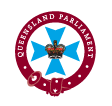-
Visit and learn
- Message from the Speaker
- About Us
- Visitors
- Visit the Public Gallery
- Visit our Gift Shop
- Have Your Say
- Get Involved
- Education and Learning
- History
- Heritage Collections
- Preservation of our Heritage
- Regional Sittings
- CPA Australia and Pacific Regional Conference
- Publications and Reports
- Speakers' Corner
- Opening of the 58th Parliament
- Parliamentary Annexe Reparation and Refurbishment
- Contact Us
On 6 June 1859, Queen Victoria approved the creation of a new colony to be called Queensland. On 10 December of the same year, Sir George Ferguson Bowen arrived in Brisbane as the new colony's Governor and officially proclaimed the Colony of Queensland.
Brisbane at this time was a small settlement of fewer than 6000 people. It is now Queensland's capital city. There was one newspaper, the Moreton Bay Courier. Amenities such as a satisfactory water supply, drainage and sewerage were lacking. In fact, water supply was sourced from ponds near Roma Street and sanitation was mainly by cesspools.
Roads were unpaved and street lighting did not exist. Issues such as drainage, health, sanitation and building design were recurring topics in the early days of the colony. It was in this environment that several of Queensland's most prestigious buildings, including Parliament House, were constructed.
From December 1859 to April 1860, Queensland was governed by an interim Executive Council. Electoral rolls were prepared and the first election was held between April and May 1860 for 26 Members from the 16 electorates established for the first Legislative Assembly. In addition, 11 men were appointed to the Upper House, the Legislative Council, for terms of five years. Later appointments were for life.
A Look at Parliament House and its Precinct
Parliament House is Queensland's premier heritage building and one of Brisbane's best known landmarks. Located on the corner of George and Alice Streets, it overlooks the expansive and majestic Botanic Gardens. It is further bound by the Brisbane River and the Queensland University of Technology. The buildings contained within the parliamentary precinct date from different stages in the history of Queensland, ranging from 1868 through to 1979. Major refurbishments of the George and Alice Street buildings occurred in 1982 and of the Annexe in 2000.Building Parliament House
The building was started in 1864, first occupied in 1868, and finally completed 25 years later in 1889. It is characterised by solid colonnades which keep the building cool in summer, some truly magnificent timber work which was produced from local Queensland timbers, and an impressive and gracious interior.
Read moreFirst Parliament House
The Queensland Parliament met for the first time on 22 May 1860, the anniversary of Captain Cook's charting of Moreton Bay, in the old convict barracks in Queen Street, roughly opposite the current Myer Centre.
Read moreThe Architect
Tiffin contributed greatly to the quality of historical architecture throughout Queensland. Apart from designing Parliament House, he was also responsible for Old Government House, the Customs House, the Old Ipswich Court House, the Lands Office, Sandy Cape Lighthouse, as well as several other buildings including churches and post offices around the state. Several projects were completed in his personal time.
Read moreNew Parliament House
Housing the Governor was the new Parliament's priority building project. As a result, the building of Government House currently located within the Queensland University of Technology grounds, commenced in late 1860.
Read more